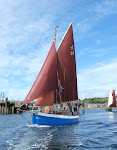After a very comfortable night tied loosely against the quay at Fraserburgh we paid our £10 mooring fee at the Harbour office, and headed out of the harbour. We had prepared everything we could while moored, even getting the bowsprit out and the no.2 jib bent on. Julian tied the anchor up to the outside of bulwarks; we did not want it rolling around on the foredeck as it probably had yesterday!
We were in the outer harbour, with a small fishing boat coming up to overtake, when the engine overheat warning sounded. I immediately got Julian to haul up the stay sail while I turned off the engine. The staysail gave us steerage way, while Julian and I looked at each other, wondering what had gone wrong. The fishing boat went past, and Robinetta continued gently towards the harbour entrance, then Julian asked if I'd remembered to turn the engine cooling water inlet back on after I checked the filter was clear. He went down to check, and it turns out I hadn't. Panic over! The engine went back on, and we headed out of harbour under power.
There was a fair amount of swell, and there were times when Robinetta's prop did not bite the water properly, so she was slow under motor. The wind felt like it was on the nose, but Robinetta is a sailing boat, so we got the main sail up, still with a little bit of reef from yesterday, and with the smaller jib she was nicely balanced on the making tack.
Julian felt a bit under the weather, but I had a lovely sail along the coast to Gardenstown, until the wind went a bit light. We shook out the reef, but it continued to drop, so we ended up motor sailing, with Julian at the helm. Unfair that he ended up with the not so nice sail!
There were only occasional other boats, but we did see a dredger on its way somewhere; a most peculiar sight when the boat bit was invisible!
The way the cliffs give way to tiny bays, some with tiny settlements hiding in them, is really interesting, as is seeing the steeply bedded rocks, which are clearly visible from out to sea. There were a couple of obvious nesting colonies on the cliffs, and I saw guillemots, kittiwakes, herring gulls, and gannets flying and fishing all around.
By the time we reached Banff the wind had died away to almost nothing. I called the harbour master on the VHF when we were ready to enter, and he was there! (he's only part time in Banff, as he's also harbour master at Portsoy) He said to come in, and he would be on the pontoon to tell us where to tie up. Wonderful.
I was on the foredeck as we entered harbour. A swell caught us as we turned towards the entrance, and for a moment, as I saw the narrow entrance sliding past, and the surf breaking on the beach to port my heart jumped. No problem really, Julian caught her perfectly and steered straight in, so we entered without any real excitement.
The harbour master was waiting as promised, and we were tied up on a good pontoon, with the right number of cleats, in minutes. Banff harbour is really pretty, and I'm very glad we came.
We had a late lunch of reheated curry left over from the generous portions served us by the B.Raj in Fraserburgh. The Omnia stove top oven is really useful at times like this.
 Julian through we would
just retrace our track along the Eynhallow Sound, then turn towards
the Wyre Sound, but I suggested we leave Gairsay to port and sail
between that and the west side of Shapinsay, and he decided that was
a better idea. I tried programming that route into the chart plotter,
but could not make it work, but Julian did. He's better at working
the chart plotter than I am!
Julian through we would
just retrace our track along the Eynhallow Sound, then turn towards
the Wyre Sound, but I suggested we leave Gairsay to port and sail
between that and the west side of Shapinsay, and he decided that was
a better idea. I tried programming that route into the chart plotter,
but could not make it work, but Julian did. He's better at working
the chart plotter than I am!




























.JPG)


























